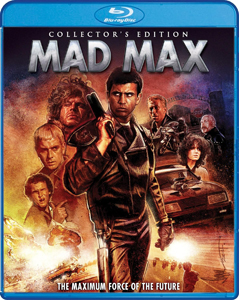“Mad Max” (1979) kicks off a now-grand sci-fi saga in rare fashion: It starts in a recognizable more-or-less present day, and thus we are treated to a steady build-up to the full dystopian world of director/co-writer George Miller’s five-film story.
Technically, “Mad Max” takes place in the near future (relative to 1979) in Australia; the only noticeable difference is that the number of biker gangs and road cops – and their importance in society – is exaggerated. It raises an interesting question about categorizing: Is a film sci-fi just because it takes place in the future?
At any rate, Starlog often mentioned the “Mad Max” films in the 1980s, and as a “Star Wars” kid I was intrigued by the notion of other SF sagas. Long after getting into the likes of “Terminator” and “Aliens,” I’m finally going on my “Mad Max” journey.

“Mad Max” (1979)
Director: George Miller
Writers: James McCausland, George Miller, Byron Kennedy
Stars: Mel Gibson, Joanne Samuel, Hugh Keays-Byrne
Over five days, RFMC looks at the five films of the “Mad Max” saga.
Sci-fi’s other legendary George
Although my delay is extreme, “Mad Max” – despite being the most profitable film, percentage-wise, of all time until 1999’s “The Blair Witch Project” – was slow to catch on in the USA. Anecdotally, it’s fascinating to watch Siskel and Ebert’s review of the sequel, 1981’s “The Road Warrior,” wherein it’s clear they don’t know about the existence of this first film.
And so I suppose it stands alone. It’s certainly a basic structure, effectively hitting on action, violence and revenge, and arguably influencing the “Fast & Furious” saga as much as its own sequels. The heroes’ and villains’ obsession with vehicles of the road is on par with those in “American Graffiti,” but setting “Mad Max” apart is that everyone is insane and they treat their cars and bikes like workhorses more so than show ponies.
Surprisingly, Mel Gibson’s Max (last name Rockatansky, the web tells me) starts off as the comparatively sane highway patrolman. As someone more familiar with “Lethal Weapon” (1987), I can imagine he grows into nutso cop Riggs over the course of “Mad Max’s” events.
Max is simply good at his job of catching speeders; in this reality, “catching” them generally means running them down till they are dead. It’s not required; it’s just that everyone drives maniacally.
This could be a stupid film except that Miller’s atmosphere and action staging are impeccable, even (or perhaps even more so) when viewed today. A viewer can almost smell the grease and exhaust as muscle cars blast along the Outback’s highways. “Mad Max” has incredible shots of carnage while presumably staying within the bounds of stunt safety – and also an uber-dark sense of humor, like motorists’ eyes bulging in shock before deadly collisions.

Revenge served cold
The character stuff is for the sake of encouraging our revenge motive in tandem with Max’s. He wants to quit after his colleague, Goose (Steve Bisley), is burned to a crisp (He can breathe OK, as long as you don’t unplug him, to quote “Blade Runner”) by the villainous Night Rider gang. But Max’s boss, Macaffee (Roger Ward), convinces him to instead take three weeks’ vacation with his wife (Joanne Samuel) and child.
You can guess what happens to said wife and child, and then we’re off on the vengeance quest, which is quite delicious, although it makes an odd choice to not save the main villain, Toecutter (Hugh Keays-Byrne), for the final showdown.
Thematically, “Mad Max” is thin compared to what will come later. Max wonders if his badge is the only difference between him and the gangs. Although some cops have (hopefully) asked themselves this question, in this case, it doesn’t totally fit; the good-evil delineation is clear.
The biggest SF flavor is the constant (for the first chunk of the film) background hum of highway-patrol radio chatter that calls to mind the bureaucratic announcements in “THX-1138.” I’m referencing George Lucas a fair amount in this write-up about George Miller, and the biggest point of comparison is speed. Both are masters of translating the feeling of speed to film, through camera tricks and editing. (Plus, John Williams helps Lucas, and composer Brian May helps Miller.)
Like “A New Hope” for Lucas a couple years earlier, “Mad Max” is the movie where Miller gets up to speed, thus allowing him to cut loose in the sequels. While Max’s family stuff in the middle might seem slow to some viewers (then again, “F&F” fans like family stuff, I guess), Miller gets up to speed fairly quickly.
“Mad Max” reviews:
Saturday, Jan. 4: “Mad Max” (1979)
Sunday, Jan. 5: “Mad Max 2: The Road Warrior” (1981)
Monday, Jan. 6: “Mad Max Beyond Thunderdome” (1985)
Tuesday, Jan. 7: “Furiosa: A Mad Max Saga” (2024)
Wednesday, Jan. 8: “Mad Max: Fury Road” (2015)

